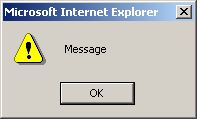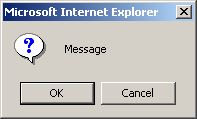Java Script Message Boxes
By Stephen Bucaro
In Java Script programming, there are many occasions when you need to display
a short message to the user, or request a bit of information from the user.
In these instances, you can use a message box.
Java Script provides three types of message boxes, the alert, confirm, and
prompt. They are all easy to create and use.
• These message boxes are "modal" dialog boxes, meaning that
program flow halts while the message box is visible. The user is unable to use the page
that spawned the message box until they click on a button to close the
message box. This may be disruptive to the user. Later in this article, I show
you how to design your own custom message box, which you may or may not
choose to make modal.

An alert presents a message with a single [OK] button to dismiss the
message box. Example code to create an alert message box is shown below.
alert("Message");
Instead of a text string for the message, you could use a variable name. The
alert function will automatically convert the value in the variable for
display, making the alert a handy tool for script debugging.

A confirm presents a message with an [OK] button and a [Cancel] button.
If the user clicks on the [OK] button, the confirm dialog box returns true.
If the user clicks on the [Cancel] button, the confirm dialog box returns false.
Clicking on either button dismisses the dialog box. Example code to create a
confirm message box is shown below.
if(confirm("Message"))
{
alert("User clicked [OK] button");
}
else
{
alert("User clicked [Cancel] button");
}
A confirm message box can be used to ask the user if a certain function should be performed.
if(confirm("Perform function?"))
{
// Code to perform function
}
| 
